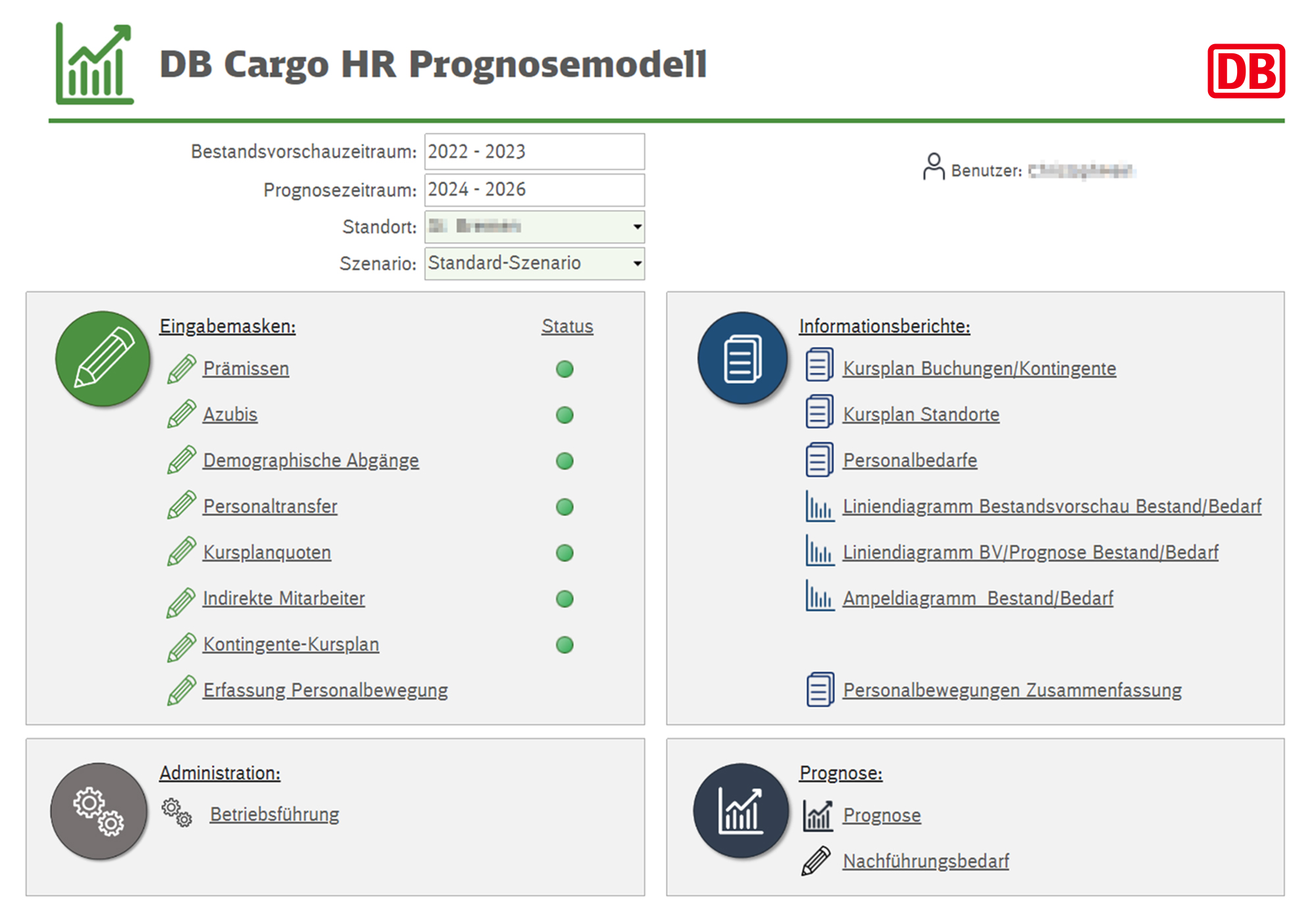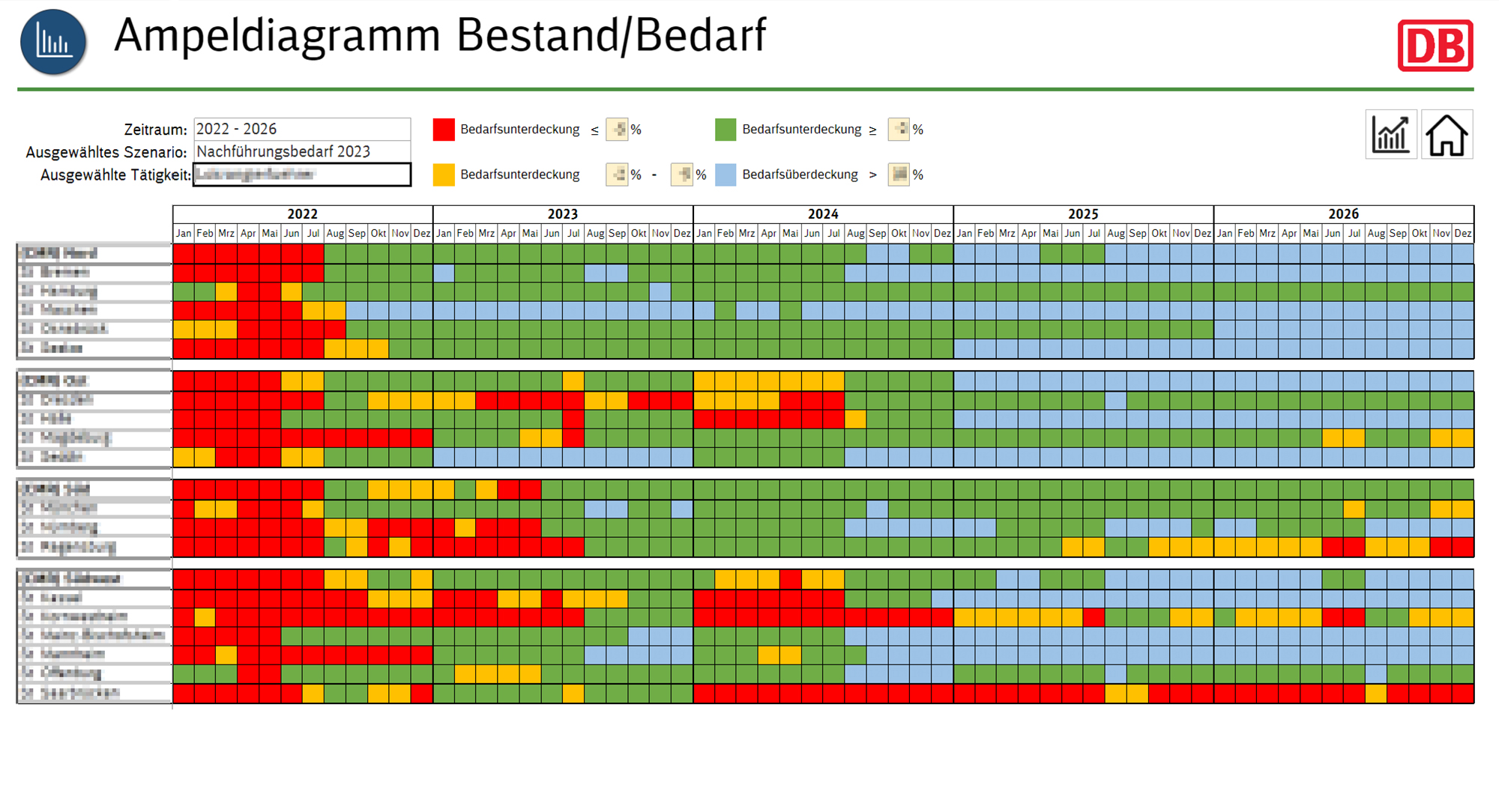Forecasting the future with business intelligence
Article: Calculating demographic change: IT-supported staff forecasting at DB Cargo
10/2023 – To deal with demographic change head on, companies need to know how many new employees they will need and when they will need them. Using hard data and smart modelling, DB Cargo is now able to forecast its staffing needs for key functions for years to come.
How can a corporate group represent complex issues clearly in order to develop concrete actions for corporate management? Long-term human resource planning is a typical case in point. Companies need to know how many new hires they will need in the future and where these new employees will be needed. This is not as simple as it sounds. Dozens of detailed questions and factors have to be taken into consideration first. Together with DB Systel, DB Cargo has developed a human resource planning and control system that provides concrete answers to these very questions.
Excel at its limit
With around 19,000 employees at 21 locations in five regions in Germany alone, DB Cargo is the largest rail freight operator in Europe. Like many other German businesses, it is facing the emerging challenges posed by demographic change. Around half of the transport company's employees are over 50 years old, and a third are over 55. In the coming years, DB Cargo expects numerous experienced specialists with valuable skills to take a well-deserved retirement.
Around two thirds of all DB Cargo employees perform "core operational functions" for the company, working in shunting services or as shunting locomotive drivers, train drivers or wagon inspectors. Without these specialists, no freight trains could run. And therein lies a particular challenge for DB Cargo: it is virtually impossible to find these highly specialised professions and qualifications on the open market. Currently, some 600 junior rail employees start their vocational training at DB Cargo each year. However, this falls far short of the number required to fill the gap mainly left by staff leaving through retirement. An additional 1,000 lateral entrants are needed so far to perform the core operational functions each year and receive function-specific training to prepare them for their new roles in the rail sector. Before they can take to the rails, all new hires first have to complete internal training lasting six to fifteen months, depending on the job profile. This explains why DB Cargo has to plan its staffing needs so far in advance.
"The challenge was to have the right number of staff with the right qualifications available in the right place at the right time."

These were the circumstances that prompted DB Cargo to find a technical solution for strategic workforce planning – a smart approach to human resource planning and control. DB Cargo already had a future-oriented forecast based on its current staff figures. However, each region had its own processes and tables for managing its staffing needs. A system for analysing and modelling expected retirements, employee turnover or internal career paths, for example, was not yet available. In addition, information on staffing needs and information on current staff figures were stored in different systems.
In practical terms, this meant that numerous individual tables with employee figures from different sources were created, sent and ultimately merged at head office with a great deal of effort in order to obtain a complete overview. "We pushed Excel to the limits of feasibility and our employees to the limits of their capacity," says Alexander Vogler from DB Cargo. Not only were these manual processes time-consuming and error-prone, but we also lacked a common data basis that was complete and up to date at all times. So, in 2019, the people responsible started searching for a clear and standardised solution for forecasting staffing needs company wide.
Business intelligence for the HR department
The solution they found has its roots in the world of finance. Which comes as little surprise since forecasting and controlling are everyday activities in that setting. Having narrowed down the options, DB Cargo settled on the "IBM Planning Analytics" business intelligence solution. This is based on the TM1 database system, which Deutsche Bahn is already using successfully in many areas where data is brought together, evaluated and visualised. DB Systel's "TeaM1", which specialises in business intelligence with TM1, supported DB Cargo as an implementing partner and took responsibility for the implementation.
"Deutsche Bahn's relationship with IBM goes back many years," says Christoph Hein from TeaM1. After all, the railway is the biggest customer for TM1 solutions. Which is why the manufacturer gets personally involved whenever new requirements and feedback arise from the railway sector. "We work closely together," says Hein. As a user of numerous TM1 instances, Deutsche Bahn is a key contact for IBM and continues to influence the further development of this solution by providing important feedback on updates, performance and required features.
Achieving a common basis for personnel data
Since the project started in 2020, DB Cargo and DB Systel have continuously endeavoured to involve all stakeholders in the process in order to ensure a high level of acceptance of the planned forecasting solution and its processes from the outset. On the technical side, DB Systel has adapted the solution to these specific requirements, optimised the HR planning and control processes and incorporated suggestions from specialists in the relevant departments into the TM1 solution on an ongoing basis.
"We have managed to cut the input effort considerably and use automation to safeguard the quality of our data. Complex forecasts and calculations now also run in real time."

Since the tool was launched in 2021, DB Cargo has benefited from a comprehensive overview of its staffing situation and, thanks to the data analysis and modelling capabilities, can now look five years into the future. This was achieved by consolidating existing data, recording specific characteristics and factoring in important trend drivers in HR forecasting such as the regional allocation of employees, employee turnover rates, specially required qualifications or specific retirement dates.

Because the qualifications required at DB Cargo are so specific, many factors have to be considered for workforce planning. For instance, train drivers hold specific licences to drive specific types of vehicles. Not everyone is authorised to drive every vehicle type. In practical terms, this means that drivers can only work where the relevant vehicle types are in use. In order to take special circumstances like this into account, DB Cargo and DB Systel have also connected the training planning tool to the new HR forecast via a live interface as part of the project. This is used to define the courses, course durations and function-specific training positions for new hires. Staffing and hiring rates are also taken into account in order to map scenarios that reflect the real world as closely as possible. This way, the system can automatically work out when, and how many, new employees will be ready to work after their training.
Looking five years ahead in HR development
HR controllers in the individual regions can now use the new analysis tool to display key figures and analyses at any time. Line charts, traffic light charts and other visualisations show clearly where staffing gaps will arise in the future and how training needs will develop over the next five years. HR managers can now see at a glance whether the traffic light for shunting services at a particular location for the year 2025 is green or red or whether the location may even end up with too many shunting specialists. The new system can map scenarios and calculate hypotheses, answering questions such as “What concrete impact will an increase in new hires today have in the future?"
At the same time, HR controllers and managers can now see the whole picture at all times. This allows the regions to coordinate with one another and, where possible, balance out staffing needs and numbers among themselves. In addition, the DB Cargo head office now has access to a comprehensive forecast at all times and can examine individual locations, occupations or historical trends in detail. Regional HR managers and head office can now work together much more effectively and analyse the staffing needs and associated trends in detail. This results in specific recommendations for action, for example, for the dimensioning of recruitment and qualification.

In practice, everyone involved now uses a uniform web application with different authorisations to change data. From the start page of the HR forecasting model, users can access the screens for the various drivers of HR development, such as employees leaving, reduced working hours and transfers, as well as dashboards for analytical reports and the final forecast. The feedback from regional HR managers is positive. They are pleased with the data consistency and glad that they no longer have to juggle Excel files. The new solution also makes it easier to input data and prevents errors by automatically checking and processing all manually entered data.
"The new solution provides high-quality, sophisticated, tailored visualisation of enormous amounts of data."

A template for HR forecasts throughout the Group
Since the launch of the driver-based HR forecast, the application has been continuously optimised and serves as a potential template for other Group companies: after all, DB Cargo is not alone in facing staff shortages and demographic change. Strategic human resource planning and forecasting is an issue in every business segment. The experience and features of DB Cargo's driver-based HR forecasting tool may generate further use cases in the future. Other business units with different job profiles also stand to benefit from business intelligence methods and tools in human resource planning. DB Systel is currently working on making this solution available to other business units in a way that meets their individual needs without sacrificing standardisation.


